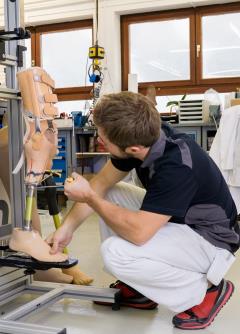Summary
Please enable javascript to play this video.
| Quick Facts: Dental and Ophthalmic Laboratory Technicians and Medical Appliance Technicians | |
|---|---|
|
$45,820 per year
$22.03 per hour |
|
| High school diploma or equivalent | |
| None | |
| Moderate-term on-the-job training | |
| 66,800 | |
| -1% (Decline) | |
| -700 | |
What Dental and Ophthalmic Laboratory Technicians and Medical Appliance Technicians Do
Dental and ophthalmic laboratory technicians and medical appliance technicians make or repair dentures, eyeglasses, prosthetics, and related products.
Work Environment
Dental and ophthalmic laboratory technicians and medical appliance technicians usually work in clean, well-lighted spaces and may spend time standing or bending. Most work full time, and schedules may vary.
How to Become a Dental or Ophthalmic Laboratory Technician or Medical Appliance Technician
To enter the occupation, dental or ophthalmic laboratory technicians or medical appliance technicians typically need at least a high school diploma or equivalent. They typically receive on-the-job training to attain competency.
Pay
The median annual wage for dental and ophthalmic laboratory technicians and medical appliance technicians was $45,820 in May 2024.
Job Outlook
Overall employment of dental and ophthalmic laboratory technicians and medical appliance technicians is projected to decline 1 percent from 2024 to 2034.
Despite declining employment, about 7,700 openings for dental and ophthalmic laboratory technicians and medical appliance technicians are projected each year, on average, over the decade. All of those openings are expected to result from the need to replace workers who transfer to other occupations or exit the labor force, such as to retire.
State & Area Data
Explore resources for employment and wages by state and area for dental and ophthalmic laboratory technicians and medical appliance technicians.
Similar Occupations
Compare the job duties, education, job growth, and pay of dental and ophthalmic laboratory technicians and medical appliance technicians with similar occupations.
More Information, Including Links to O*NET
Learn more about dental and ophthalmic laboratory technicians and medical appliance technicians by visiting additional resources, including O*NET, a source on key characteristics of workers and occupations.
 United States Department of Labor
United States Department of Labor







